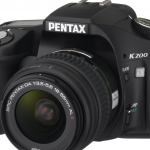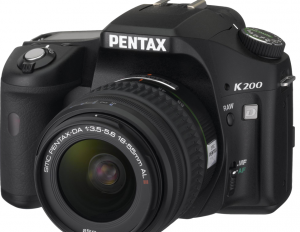
When I recently posted my guide to choosing your first dSLR, I was ripped to shreds in the comments for overlooking Olympus and Pentax… Which is quite wrong of me: Pentax have long made some pretty awesome cameras, with features that Canon and Nikon haven’t had (like being able to remote control external strobes – a feature Canon has never had until the introduction of the Canon 7D!)
Someone who was particularly outraged is the most fabulous John Cavan, who wrote a passionate and well-articulated plea to stop ignoring Pentax – and he’s got a pretty damn good case, actually… here’s why:
Canon, Nikon. Nikon, Canon. When most people think of buying a dSLR, that is often the debate that they wage with themselves. Of course, with the Sony purchase of Minolta, they may even now start to think of Sony in that debate. There is, however, another player on the market, a player that has been around for a very long time. In fact, they were once synonymous with SLR photography: Pentax.
Pentax is the first Japanese company to release a 35mm SLR in 1952 and, for quite a while, were the defacto standard for 35mm photography. The M42 screw mount, while not a Pentax invention, was made so prevalent by Pentax that it became known as the Pentax mount. In a sense, Pentax ushered in the age of SLR photography producing more cameras than all other manufacturers combined. So, what happened to them? They didn’t fall off the 35mm radar, even as they lost ground to names like Nikon and Canon, Pentax continued to innovate, but they were the last to move from the limited capability of the M42 mount and, to some degree, that probably hurt them the most.
However, Pentax didn’t go away. They continued to produce excellent cameras, including the classic K1000, first created in 1976 as a basic SLR, it managed to outlive all of its brethren and almost all successors because of its elegance and simplicity, finally hitting end of life in 1997. In 2003, Pentax entered the digital age and didn’t stop their innovation. By this time, however, the Canon/Nikon duopoly was pretty complete. A tough nut to crack, no?
Pentax is trying to crack that nut, so I’m going to talk about Pentax as it started getting serious about dSLR photography with the arrival of the K100D, K110D, and the K10D. The first two were the entry level dSLRs and the last was aimed at the prosumer. As with all of their cameras, Pentax focussed on certain key areas: backwards compatibility and the photographic experience. These are factors that continue to be key to Pentax since the introduction of these cameras, so let’s talk about them.
Backwards compatibility is a funny statement with digital, but it is applicable because it means that over 50 years of high grade optics are still available to you. Many of us Pentaxians have in our kits lenses that the modern dSLR owner wouldn’t even think of, wouldn’t even be aware of. We don’t have these lenses because there aren’t modern options for Pentax, because we have those too, but because they present optical quality as good as any current lens and at a price that you can’t hope to beat brand new. To give you an example, I own a Vivitar Series 1 100mm f/2.8 Macro manufactured by Kiron. This lens is widely regarded as one of the best, if not the best, macro lens ever produced and it’s nearly 40 years old. I paid $160 (Canadian) for it. To compare, a Canon EF 100mm f/2.8 Macro lens currently retails for $730 or $1249 with image stabilization.
Another backwards compatibility feature, which makes my last comment even more interesting, is Pentax image stabilization (or anti-shake) is in the body of the camera. There are certainly advantages to IS on the lens, such as IS in the viewfinder, but the single biggest advantage to it on the body is that every single lens I attach to my Pentax, regardless of age, can be stabilized. Of the major dSLR manufacturers, only Sony can say that, and they don’t have the lens history of Pentax. There’s another advantage: price. You can see that above, IS adds $500 to the price for what is otherwise the same lens.

For your first step into the world of digital photography, look beyond the two big brands for some creative features and competitive pricing!
Now, of course, Pentax isn’t just leaving us in the world of historical lenses, scouring eBay and Craigslist so that we can take pictures. They do have a very good line-up of modern lenses with zooms and primes, wide to telephoto including what many, such as DP Review, call highly desirable limited lenses. It isn’t just Pentax, we also have Sigma, Tamron, and others producing good optics for a good price. So, with Pentax, you can pull from the old (even ancient, M42 can be adapted to the modern bayonet mount) and the new. Heck, with an adapter, you can even put a monstrous medium format lens on it! I know a local photographer that uses his Pentax 67 lenses on his K20D all the time.
Alright, I think I’ve established that Pentax is good at keeping the old available to the new, but I also mentioned the photographic experience. Most modern dSRLs offer what I would call point-and-shoot features and, to some degree, that is a wise choice. Pentax took a different approach, aiming their line at people looking to have the pleasure of the 35mm film experience in a digital package. So, instead of scene modes on the dial, they added things like hyper-program (a way to quickly switch between aperture and shutter priority modes), sensitivity priority (control ISO with the rear dial), and shutter/aperture priority (camera sets ISO based on shutter and aperture). Other ideas, such as the “green” button near the shutter release that quickly resets the exposure, even in manual, giving you a good starting point for creative adjustment. They also have the RAW+jpeg button that will easily give you both formats for the next shot, a feature that just made it to Canon now.
So, where is Pentax today? Well, they have a line up modern dSLRs that have continuously received top reviews time and again. In the entry market, we have the K200D, K-m and the K-x cameras. The K-x is the newest and is something worth talking about, so much so that Photography blog gave it a rare “essential” rating. At the higher end, we have the K20D and the K7, both very highly regarded. The K7 was recently compared to the latest Canon prosumer (the 7D) on DP Review and came out very close, but also costs quite a bit less. I’m not going to go into detailed features for them, this is widely covered on the Internet, but I will note that the prosumer versions of the Pentax line offer a number of features that are usually only seen in substantially more expensive cameras. Where Pentax lacks is at the truly pro end of the spectrum, something they hope to rectify with a medium format digital in the new year. Mind you, that’s probably more than most of us would wish to handle if we’re not doing commercial photography.
In any case, I’m not writing to convince you to buy Pentax (it means more great lenses for me on Craigslist if you don’t), but to consider it. Canon, Nikon, and Sony all produce excellent cameras as well. I don’t think you, as the consumer, are going to be left feeling cheated with any of them. My only advice would be to get your hands on to the cameras and try them, all of them. The feel, the weight, and the placement of the controls are all going to be factors that should influence you as much as anything and that you can only get by putting it into your hands with a decent lens. If you do that, in a good photography store that lets you, then I think you’ll find that Pentax is as good as any of them and perhaps, now, the debate you wage won’t just be Canon, Nikon or Nikon, Canon.
About John
John is a software architect that just happens to be an avid amateur photographer. He did a lot of 35mm film (used Yashica and Pentax) in college as the editor of the newspaper, but then kind of let it slide for years after that because he could never be bothered to develop the film. Ultimately, he got back into photography with the Pentax K10D and then it just went from there. Check out his website, too!
Do you enjoy a smattering of random photography links? Well, squire, I welcome thee to join me on Twitter -
© Kamps Consulting Ltd. This article is licenced for use on Pixiq only. Please do not reproduce wholly or in part without a license. More info.








